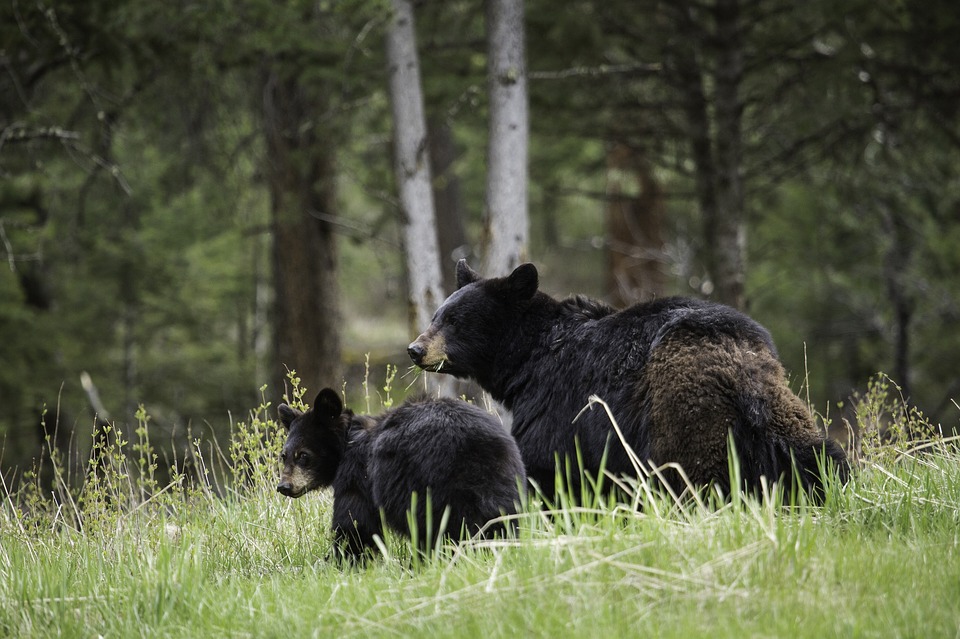The North Saskatchewan River
Flowing through the Edmonton region is a large streak of blue, the North Saskatchewan River. Originating in the Saskatchewan Glacier in the Columbia Icefield, it flows through Alberta and Saskatchewan, where it combines with the South Saskatchewan River to form the Saskatchewan River, which then continues into Manitoba and eventually meets the sea in Hudson’s Bay.
Along the way, the river provides drinking water to Edmontonians and many other municipalities, as well as plentiful recreation opportunities. This waterbody has also been used historically as a key transportation route during the fur trade. But the river provides much more than just resources for humans - it is also a wildlife corridor that provides important resources for a wide variety of animals.
Public Domain
What is a Wildlife Corridor?
The term wildlife corridor simply refers to a natural area with little to no human development that allows animals to travel between different habitat types and natural areas. In simple terms, it is a natural pathway for wildlife. This term has been applied to the North Saskatchewan River Valley here in Edmonton, as it is the heart of the largest expanse of urban parkland in North America. In order for this corridor to continue to be effective, it needs to remain intact and non-fragmented - a pathway without any roadblocks. Fragmentation, or breaking the land into smaller parts via human activities, can separate species from others of their own kind and from resources.
Animals that move through this corridor may be using it as part of their daily movements or as part of their seasonal migration. For example, many of our native songbirds are migratory and use this wildlife corridor as a key stopover sight or nesting area. In contrast, reptiles such as the Red-sided Garter Snake are not migratory, but still use this area for their daily movements. Larger mammals will likely have greater movement needs, as they need more space and resources to sustain their populations.
Coyotes
You can identify a coyote by their narrow pointed face, bushy tail, large ears compared to body size, and relatively smaller than a wolf. Photo by Gerald Romanchuk.
One of the larger mammals to use this wildlife corridor is the coyote. The native species is highly curious, intelligent, and adaptive. This contributes to their generalist lifestyle, which enables them to adapt to new environments and food sources more easily than some other species. Part of their diet is small rodents, which are common in the river valley. As they hunt these, they fulfill the natural and beneficial role of managing rodent populations, and thereby acting as nature’s pest control. With their incredible sense of smell, they may travel large distances along the river in search of food. But this wildlife corridor doesn’t have solid boundary. This means that the inquisitive species may roam outside the forested areas in search of easy food opportunities, sometimes causing concern for home and pet owners. You can find more information about human-coyote encounters in Edmonton here.
There is still much to learn about coyotes in Edmonton’s River Valley, and one group aims to help fill in some of the blanks. The Urban Coyote Project is a group trying to answer questions such as how they move through the city, how big are their home ranges, and which habitats they prefer. Answering these questions will provide us with a larger picture of how coyotes make use of this wildlife corridor. Research is done using GPS collars, remote cameras, and scat collection from parks and natural areas across the city.
Black Bears
One large mammal making recent news headlines in Edmonton are Black Bears in the river valley. Some may associate this species with the mountains or deep within Alberta’s northern forests, but Edmonton actually falls very close to the natural range of this species. With their great sense of smell, broad diet, and ability to travel great distances, they can make great use of our wildlife corridor. This species can have large home ranges, with females covering 10-40 km², and males up to 100 km². River valley bottoms and sunny sides of trails provide excellent habitat for berries and other plants which make up over 90% of a bears diet.
Luckily, humans are not on the menu and attacks are rare, but there are ways to help prevent the chance of a negative encounter. Bear Smart is one tool that provides reliable information to help stay safe.
Black Bears comes in many colors, including brown, blonde and cinnamon variations. Photo by Neal Hebert, NPS
Living in a Wildlife Corridor City
The North Saskatchewan River, its tributary streams, and the connected natural areas, all offer habitat opportunities for local wildlife. Living amongst and recreating within this wildlife corridor, means living alongside wildlife. There are a few simple tips to keep both humans and wildlife safe.
Give wildlife their space. This is for your safety and theirs.
Don’t feed the wildlife. Human food can be unsafe or hazardous to some species. It can also habituate species, meaning they will have more interactions with humans, which is normally not beneficial for wildlife. Some animals can also become aggressive around food, causing issues for humans. Let wildlife stick to their natural food sources.
Keep cats indoors. Outdoor cats can do serious damage to local bird populations. Read more on our blog.
Take time to enjoy this fantastic natural wildlife corridor! The City of Edmonton has many parks within the river valley. Check them out here, or come explore an Edmonton and Area Land Trust conservation land, Larch Sanctuary, which follows Whitemud Creek; a stream which connects to the North Saskatchewan River.



